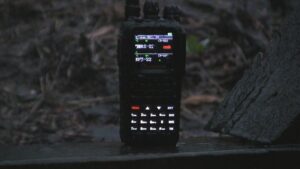
Two way radios see use in many types of environments. We've sold radios to responders to the flooding caused by hurricane Katrina, soldiers to use in the deserts of Iraq, and most everyone in between. As you can imagine, we frequently get questions about how well certain radios hold up to exposure to water and dust.
There are different levels of waterproofing and dust proofing. For example, a radio that is resistant to a light rain will not necessarily hold up when submerged in a pool of water. When shopping for a product, it is important to know how resistant the product is to water and/or dust, and fortunately for us there are standards in place for measuring such things. There are two specifications for which we commonly see radios rated: JIS and IP.
Japan Industrial Standards (JIS)
The JIS scale measures water resistance with levels ranging from 0-8.
- JIS-0 - No special protection
- JIS-1 - Vertically dripping water shall have no harmful effect (Drip resistant 1)
- JIS-2 - Dripping water at an angle up to 15 degrees from vertical shall have no harmful effect (Drip resistant 2)
- JIS-3 - Falling rain at an angle up to 60 degrees from vertical shall have no harmful effect (Rain resistant)
- JIS-4 - Splashing water from any direction shall have no harmful effect (Splash resistant)
- JIS-5 - Direct jetting water from any direction shall have no harmful effect (Jet resistant)
- JIS-6 - Direct jetting water from any direction shall not enter the enclosure (Water tight)
- JIS-7 - Water shall not enter the enclosure when it is immersed in water under defined conditions (Immersion resistant)
- JIS-8 - The equipment is usable for continuous submersion in water under specified pressure (Submersible)
IP Code (International Protection Rating)
The IP code is commonly used by business radios, and it contains a rating for resistance to both liquids and solids. With radios, solids typically refer to dust and other fine particles, but the IP code is designed to include larger objects. An IP rating has two digits, "IP54" for example. The first digit (5 in the previous example) refers to resistance to solids. The second digit (4 in the previous example) refers to resistance to liquids.
Solids Resistance Levels (First Digit)
The following is the numeric resistance level, and the types of solids that are resisted at that level.
- 0 - No protection against contact and ingress of objects
- 1 - Any large surface of the body, such as the back of a hand, but no protection against deliberate contact with a body part (>50 mm)
- 2 - Fingers or similar objects (>12.5 mm)
- 3 - Tools, thick wires, etc. (>2.5 mm)
- 4 - Most wires, screws, etc. (>1 mm)
- 5 - Ingress of dust is not entirely prevented, but it must not enter in sufficient quantity to interfere with the satisfactory operation of the equipment; complete protection against contact
- 6 - No ingress of dust; complete protection against contact
Liquids Resistance Levels (Second Digit)
These are similar to the JIS standard (above).
- 0 - Not protected
- 1 - Dripping water (vertically falling drops) shall have no harmful effect.
- 2 - Vertically dripping water shall have no harmful effect when the enclosure is tilted at an angle up to 15 degrees from its normal position.
- 3 - Water falling as a spray at any angle up to 60 degrees from the vertical shall have no harmful effect.
- 4 - Water splashing against the enclosure from any direction shall have no harmful effect.
- 5 - Water projected by a nozzle (6.3mm) against enclosure from any direction shall have no harmful effects.
- 6 - Water projected in powerful jets (12.5mm nozzle) against the enclosure from any direction shall have no harmful effects.
- 7 - Ingress of water in harmful quantity shall not be possible when the enclosure is immersed in water under defined conditions of pressure and time (up to 1 m of submersion).
- 8 - The equipment is suitable for continuous immersion in water under conditions which shall be specified by the manufacturer. Normally, this will mean that the equipment is hermetically sealed. However, with certain types of equipment, it can mean that water can enter but only in such a manner that it produces no harmful effects.







DeWALT DXFRS300 FRS Business Radio Value Pack (2 Radios + Carpieses)
Que tamaño tiene este radio
Gracias
How big is this radio
Thanks
The dimensions are approximately 6.22" x 2.15" x 2.37" (157.96mm x 54.6mm x 60.16mm). The specs are listed on the product page for the DXFRS300.
I am looking for FRS radios for my CERT Team, about 20 radios.
I will consider other radios as long as a license is not required for operation. The team has to buy their own radios.
How do I get a meaningful comparison between JIS and IP
In other words one version of a product is rated JIS7 and another version is rated IP67 - the latter seems more specific.
What to I tell my customer?